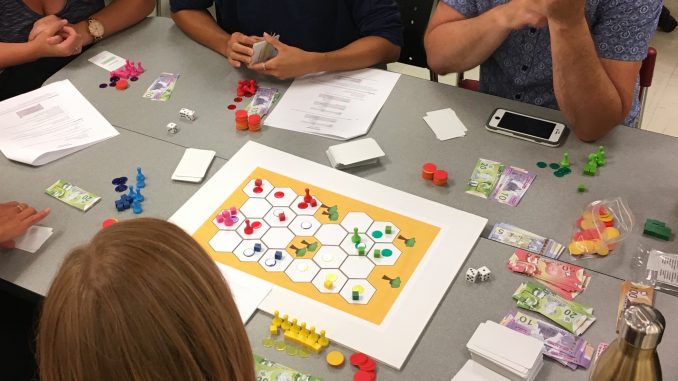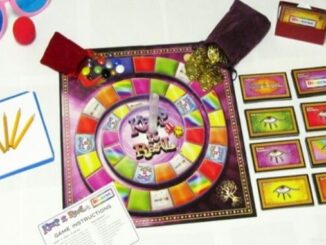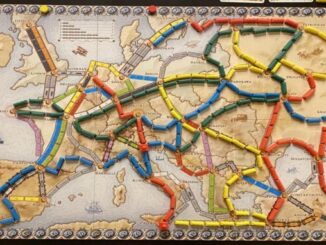
Systems thinking is one of the competencies that enable us to understand the complexity of global and networked structures and their outcomes. The interconnectivity between countries, companies, and people creates a net of relationships that have evolved exponentially since the technology revolution at the end of the 20th century (Castells, 2010). In our work, we attempt to design pedagogical interventions to foster systems thinking in teaching and learning contexts. In this paper, we present one of our design efforts in sustainable development education.
Sustainable development is a complex problem encompassing an interrelationship between different domains such as society, environment, and economic agents in different levels (local to global) (Weijs, Bekebrede and Nikolic, 2016). To address the complexity of systems thinking and sustainable development, we designed a board game, Green Economy and developed a game-based learning approach utilizing this game (Gatti Junior, Kim, et al., 2020; Gatti Junior, Lai, et al., 2020). The game design began with a simple prototype (Figure 1) and finished after 10 weeks.

Why a game?
Games are models of systems (Kim and Bastani, 2017) and systems themselves (Fullerton, 2008) which makes game play and game design promising learning tools for complex issues. Playing a game that invites the players to participate in the system itself helps to cultivate systems thinking in diverse age groups and contexts. For example, Goodwin and Franklin (1994) designed a Beer Distribution Board Game for adult learners in management development programs to experience the product distribution system. Castronova and Knowles (2015) also explored how a board game about climate systems can be played by university students to learn about and (hypothetically) participate in climate policy making. More recently, Nordby, Øygardslia, Sverdrup, and Sverdrup (2016) observed the potential of their digital game about ecosystems for elementary students’ experiencing and learning about the system. From the constructivist and situated learning perspective (Lave and Wenger, 1991), games situate knowledge within the modeled system and, therefore, simulate a meaningful context for systems thinking.
Why a board game?
Green Economy encompasses both the gameplay and game design experiences in one experiential game-based learning activity. By incorporating a unique feature that enables players to change the rules during the game play, we invited the players to act as game designers during the game play. Both play and design engages students in systems thinking as they need “to think about how various parts of a system (e.g., different subsystems within a system) or different systems interact with each other” (Gee, 2009, p. 6). The board game as a tool embodies design possibilities based on low-cost resources and can easily be used in formal and informal learning settings without computers, internet access, or other technical devices. Additionally, a board game requires much prior experience for learners to play or design (e.g., coding) and provides an immersive learning experience.
In Green Economy, players are invited to engage in the reasoning of sustainable development. They lead a nation through two distinctive stages. They gather and manage resources (including land and Gold) in the first stage to build facilities that will allow them to evolve as a civilization into the second stage.
The game board is formed with hexagons (Figure 2), and each hexagon represents a land; the cards include resources, chances cards, and rules cards. The game encompasses other elements that represent population, Gold, factories, and army. The first nation that reaches a certain degree of wealth without negative environmental points wins the game.

In the first stage, players must have land, Gold, technology, and mineral to build factories and armies. The Factory is the element of the game that provides Gold for players. In each turn, a player receives for each factory owned 1 Gold and 1 negative environmental point. Yet, the army can move throughout the board one land per turn and only to adjacent land. The players may (but are not required to) build or use armies to protect their own lands and factories, to conquer an available land and/or to attack other players’ land. When players use their army to conquer an empty land, they receive 1 negative environmental point. When they use the army to attack another player, they receive 2 negative environmental points.
To win the game, a player must present 10 Golds, 1 stage two factory, and 0 (zero) environmental points. It means that some decisions in the first stage (the use of the army and build factories) will lead players to deal with a critical burden at the second stage. Thereby, we argue that this game play mechanism helps players (as students) reflect on their decisions and the consequences of their actions for the environment.
The feature introduced in our design that fosters the system thinking in-depth is the rule change cards (Figure 3). These cards introduced learning opportunities in our game anchored in new design possibilities that emerged during the game play. The players often have the chance to transform the result of the game completely as we could observe in one of the tables in playtesting with master students when the group started playing collaboratively to attack a player who would win the game. In this particular game, a joint attack was possible when one of the players, who had a rule change card, allowed players to move their armies more than one land per turn. One of the students shared his observation, and acknowledged,
“Once the rule change cards came into play the objective began to focus on how to extend or manage the play between the entire group. The change of rules began to happen to instigate events in creating game play that would promote a deep group interaction.”

One of the important moments from the learning process using games is the discussions conducted by instructors after the game play. During the debriefing sessions, players learned from the decisions made and their consequences in the game. Similarly in the Beer Distribution Game (Goodwin and Franklin, 1994), players acted in the roles of the factory, distributor, wholesaler, and retailer, aiming to consider cost-effectiveness. After the gameplay, players in different positions drew a graph of the pattern of customer demand. While explaining what happened in the game, most students thought other players’ behaviors had ripple effects on their game performance, but seldom noticed the impact of the larger game structure and how their own behaviors contributed to systems result. After collaboratively reviewing and analyzing how the system worked with videotapes of their gameplay, students were able to interpret with systems perspective (Goodwin and Franklin, 1994). The study by Nordby et al., (2016) similarly encouraged elementary students’ reflective practices of writing diaries on ecosystems based on their gameplay and holding debriefing sessions. In Green Economy, through the reflection on the decision making during the game play, we could see that students were involved in systems thinking recognizing elements and their relationships in the game, as well as organizing those components and the process of the game system. Through the interaction of different game design elements that supported social interaction and the formulation of emerging strategies, it was possible to see how players were engaged in systems thinking emerged in a social gaming experience.
Our research seeks to contribute to a growing wave of game design for educational purposes (serious games) that encompass not only the creation of digital games but also card and board games (Kwok, 2017). Our work contributes to a critical discussion concerning the integration of elements of game design and learning theories for developing a board game that enables educators to enhance player’s systems thinking.
Acknowledgment: The authors acknowledge the work of Liping Liu and Xingru Lai (former master’s students at the University of Calgary) who were part of the game design team.
References and further reading:
Castells, M. (2010) The rise of the network society. 2nd edn. Chichester, UK: John Willey & Sons.
Castronova, E. and Knowles, I. (2015) ‘Modding board games into serious games: The case of Climate Policy’, International Journal of Serious Games, 2(3), pp. 41–62. doi: dx.doi.org/10.17083/ijsg.v2i3.77.
Fullerton, T. (2008) Game design workshop: A playcentric approach to creating innovative games. 2nd edn. Burlington, MA.: Morgan Kaufmann Publishers.
Gatti Junior, W., Kim, B., Liu, L. and Lai, X. (2020) ‘Green Economy game: A modular approach for sustainable development education’, International Journal of Designs for Learning, 11(2), pp. 96–107. doi: 10.14434/ijdl.v11i2.25020.
Gatti Junior, W., Lai, X., Kim, B. and Liu, L. (2020) ‘Green Economy: A board game to support systems thinking’, in Friesen, S., Brandon, J., and Jacobsen, M. (eds) Selected Proceedings of the IDEAS Conference: Transforming Pedagogies. Werklund School of Education, University of Calgary, pp. 44–50.
Gee, J. P. (2009) ‘Games, Learning, and 21st Century Survival Skills’, Journal of Virtual Worlds Research, 2(1), pp. 1–9.
Goodwin, J. S. and Franklin, S. G. (1994) ‘The beer distribution game: Using simulation to teach systems thinking’, Journal of Management Development, 13(8), pp. 7–15.
Kim, B. and Bastani, R. (2017) ‘Students as game designers: Transdisciplinary approach to STEAM education’, Alberta Science Education Journal (ASEJ), 45(1), pp. 45–53.
Kwok, R. (2017) ‘Game on’, Nature, 547, pp. 369–371. doi: 10.1038/nj7663-369a.
Lave, J. and Wenger, E. (1991) Situated learning: Legitimate peripheral participation. Cambridge: Cambridge University Press.
Nordby, A., Øygardslia, K., Sverdrup, U. and Sverdrup, H. (2016) ‘The art of gamification; teaching sustainability and system thinking by pervasive game development’, Electronic Journal of e-Learning, 14(3), pp. 152–168.
Weijs, R., Bekebrede, G. and Nikolic, I. (2016) ‘Sustainable competence development of business students: Effectiveness of using serious games’, in Bottino, R., Jeuring, J., and Veltkamp, R. C. (eds) Games and Learning Alliance: 5th International Conference, GALA 2016, Utrecht, The Netherlands, December 5-7, 2016, Proceedings. Cham: Springer International Publishing, pp. 3–14. doi: 10.1007/978-3-319-50182-6_1.
- Board games to engage in systems thinking - 12th January 2021
- Board games to engage in systems thinking - 12th January 2021




Nice one, I would like to play this game with my children. sustainability is very close to my heart. is it available online or otherwise
Hi Njeri,
I can send you the printable game components and rule book if you wish. Just send me an email.
Good day! Can you please send the printable game components and rule book for the Green Economy Board Game to me please? Much appreciated! Warm regards Liezl
Please send it to me too.
[email protected]
Thank you!
Hello Wilian and Beaumie, and congratulations on designing what looks like a very interesting, entertaining and informative experience. I would love to try it out with a group of junior high school students as part of the sustainability stream. If you still have the materials available, I would be most appreciative to receive them. And I would be pleased to give you a report on how it worked.
Than you indeed
BTW, my email address is
[email protected]
Dear Wilian and Beaumie,
congratulations on designing this interesting game.
I would love to try it with a group of student.
I appreciate if you can send me the printable version of the game.
Best regards
Reza
Hi, could you send me the components etc. too? [email protected]
Kind regards,
Josef